Cannon armored vehicles "Mannesmann-Mulag"
For the manufacture of armored vehicles, several chassis of passenger cars of the Russo-Balt plant were sent to the Izhora plant, as well as a number of foreign-made trucks. The chassis of the domestic assembly in the future became the basis for armored vehicles "Type C", and on the basis of imported technology built machines of other types. Among other vehicles, several German-made Mannesmann-MULAG trucks were sent to the plant. A number of such machines were received from Germany shortly before the outbreak of the war. Due to the difficult situation with cars, it was decided to use a few German vehicles as a base for combat vehicles.
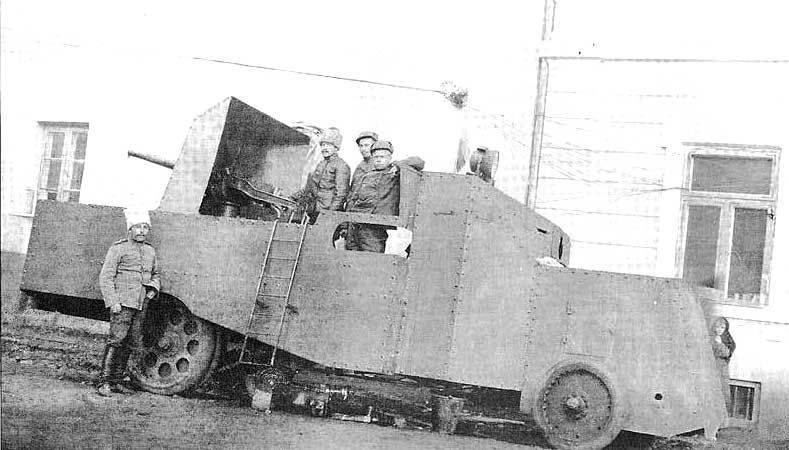
The first armored vehicle "Mannesmann-Mulag". Photo of Wikimedia Commons
Colonel Dobrzhansky, together with colleagues from the military department and specialists from the Izhora plant, quickly developed several reservation and armament projects for the existing chassis at once. So, it was decided to build light armored vehicles with machine-gun armament on the Russo-Balt chassis, and the trucks should be the basis for heavy armored vehicles with artillery pieces. It was assumed that the simultaneous operation of machine-gun and cannon armored cars would significantly increase the combat capabilities of the formations.
The base truck Mannesmann-Mulag, chosen as the basis for a heavy cannon armored car, had a classic for that time bonnet layout with a relatively long wheelbase. The chassis was equipped with a hp 50 petrol engine. German production and chain transmission. Odnoskatnye front and twin rear wheels mounted on leaf springs. In the basic configuration of an onboard truck, the car could carry up to 4 tons of various cargoes.
Despite the large carrying capacity, it was decided not to make a large and fully closed armored hull. Such a design, with too much weight, could degrade the mobility of the finished machine. For this reason, only the driver’s cabin and the engine compartment received a full reservation. The fighting compartment, in turn, was made in the form of an open area with sides and a gun shield. The hull was made of 5 armor plates (forehead and shield) and 4 mm (all other parts) that were installed on the frame.
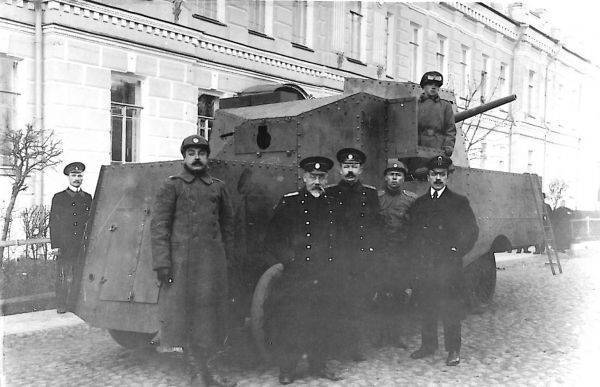
Cannon armored car and officers. Photo Aviarmor.net
The engine compartment was closed by a box-shaped casing made of several even armor plates. There was an inclined frontal sheet with a double hatch for ventilation and vertical sides with hatches for servicing the engine. The roof of the hood was strictly horizontal. To improve the protection of the side and forehead of the hull, they fell below the frame, thanks to which it was possible to protect some of the undercarriage units, primarily springs and axles, from bullets and fragments. The wheels were located outside the body and had no protection other than metal discs.
Behind the engine compartment was the driver’s cab and gunner. The need to ensure a smooth transition between a narrow hood and a wide body affected the shape and size of the cab. Directly with the hood were mated two skewed cheekbones of different shapes. The front part of the cab consisted of two parts: above the hood was vertical, to the right of which provided for a sloping triangular. In the latter, there was a driver's viewing slot, in the vertical - an embrasure with a sliding shield. Behind the cheekbones attached vertical side sheets. The front part of the roof was installed with a slope, the rear - strictly horizontally. There was a mount for the spotlight.
The open combat compartment of the Mannesmann-Mulag armored car was a reserved on-board body of the base truck. With minimal changes to the existing structure, side and stern sheets were installed on it. To protect the transmission and fuel tank, the front of the sides fell lower than the rear, the dimensions of which were due to the design of the chassis.
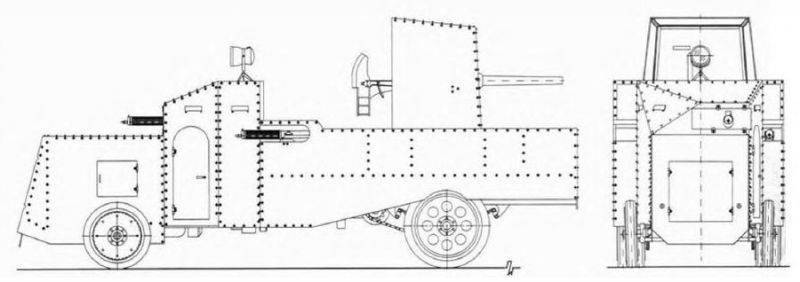
The scheme of the first armored car of the series. Drawing Solyankin A.G., Pavlov M.V., Pavlov I.V., Zheltov I.G. Domestic Armored Vehicles. XX century
A gun mount was placed in the bodywork: a cupboard for a cannon with an armored seat. The latter had a frontal sheet with a slight inclination to the vertical, sloping sides and a sloping roof. This design of the shield provided an acceptable level of protection for the gun crew, and did not interfere with access to the gun and had an acceptable weight.
The crew of the new armored car consisted of five people. The driver and the gunner commander were located in a closed cockpit, and two gunners and another gunner were in the open area. Access to the cockpit and the site was provided through the door in the right cheekbone of the hull. In addition, with proper skill, it was possible to climb over the side, for which there was a hanging ladder. To monitor the expensive driver had a viewing gap in the frontal, zygomatic and side parts of the cab. The commander could observe through the embrasure of the front machine gun. The rest of the crew could use the hatch in the armor guard of the gun.
Armored cars based on the Mannesmann-MULAG truck had to carry cannon and machine gun weapons. With this composition weapons different machines were noticeably different: they were affected by a shortage of weapons that arose at the initial stage of the war. The main weapon of the first armored vehicle of the new model was the Sea gun of the Hotchkiss caliber 47 mm. It was installed on the pedestal cargo area. For optimal distribution of loads, a cabinet with fasteners for armored seats was located directly above the rear axle. The design of the cabinet and the shield allowed firing within the horizontal sector with a width of about 26 °. Ammunition in the form of 1200 shells was stored in boxes in the back of the car.
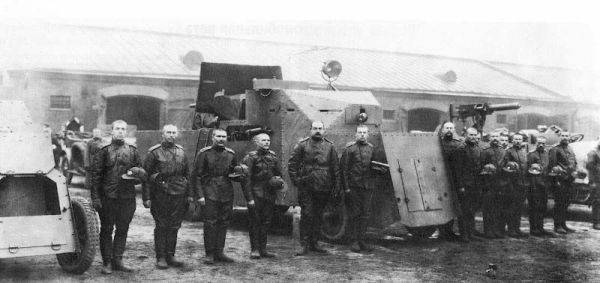
Personnel and equipment 1-th automotive machine-gun company. On the left is the hood of the armored vehicle "Russo-Balt Type C", in the center - "Mannesmann-Mulag". Photo Aviarmor.net
The additional armament of the first armored vehicle of the series consisted of two Maxim machine guns. The first one was installed in the cab front plate in the embrasure of the Dobrzhansky construction. This embrasure was a relatively wide hatch with a movable flap-cover, in the center of which there was a hole for a machine gun. Thus, inducing a machine gun in a horizontal plane, the commander-shooter shifted the flap to the sides, so that the hatch was constantly closed. The second machine gun should be installed in one of the two windows in front of the sides of the rear platform. The ammunition of both machine guns was 8 thousand cartridges in tapes. If necessary, an armored car could carry the crew’s personal weapons, hand grenades, a stock of explosives, etc.
Used weapons can effectively attack the infantry, equipment and some enemy fortifications at distances up to 2 km. At the same time, however, the real effectiveness of the fire depended heavily on some factors, such as terrain relief, etc. In addition, there was no possibility of simultaneously firing a single target from a cannon and a machine gun. However, the presence of a gun fighting vehicle could seriously increase the overall firepower of the unit.
By September, 1914, the Izhora plant managed to build one armored mannesmann-Mulag. This machine was planned to be used in the same company with the Russo-Balt Type C machine-gun armored vehicles and several unarmored trucks, which only had time to install weapons. The new compound, armed with armored cars, called the 1-th automobile machine-gun company. The only gun armored car identified in the 1-th platoon of this company.
October 19 company sent to the front. For the first time a new military equipment took part in the battles in early November. The machine gun and cannon machines of the 1 Company created a real sensation. They were a serious force that could change the course of the battle. The absence of any proven methods to combat armored vehicles further complicated the position of the enemy. So, on November 9 and 10, two vehicles with artillery pieces supported the 9 and 12 regiments of Turkestan rifle regiments. The result of the effective interaction of infantry and combat vehicles was the rapid liberation of the city Strykov. The enemy suffered heavy losses.
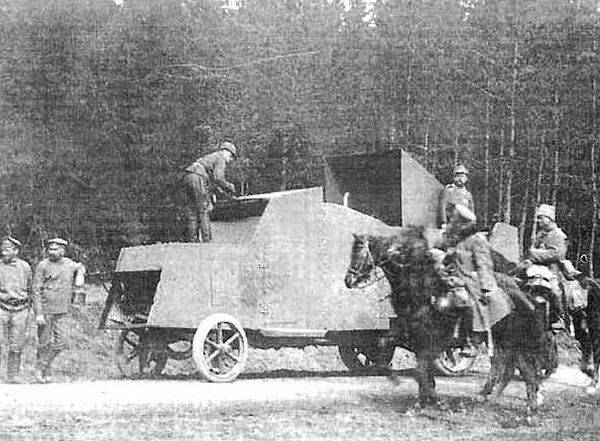
Armored car of the second series. Photo by Aviarmir.net
1-I automotive machine-gun company without a loss continued to participate in the battles for a long time. However, sometimes during battles armored vehicles were damaged. At the very end of 1914, for this reason, they had to abandon the further exploitation of the only armored vehicle, Mannesmann-Mulag. In combat, the car received serious damage, because of which its further use was not possible.
By this time, work on assembling new armored cars of the same type was completed at the Izhora plant. By the end of the year, the assembly of two more machines based on the Mannesmann-MULAG chassis was completed. These armored cars had a number of noticeable differences from the first sample. First of all, they were associated with the base chassis and the composition of weapons.
Due to the lack of technology, the armored vehicles of the “second series” were built on the basis of the three-ton chassis of the Mannesmann-Mulag. With a similar design, this chassis was equipped with an 42 hp engine. Smaller engine power and carrying capacity forced to finalize the project. So, it was decided to abandon the second machine gun, leaving only located in the cabin. Embrasures in the sides of the body disappeared, and over them appeared enlarged side, providing additional protection for gunners.
47-mm gun was replaced with 37-mm gun Hotchkiss. Replacing the gun was associated with the need to reduce the weight of the structure, as well as with the characteristics of the original gun. Despite the larger caliber, the 47-mm gun had a less powerful high-explosive shell. Characteristics of other 37 mm ammunition were acceptable.
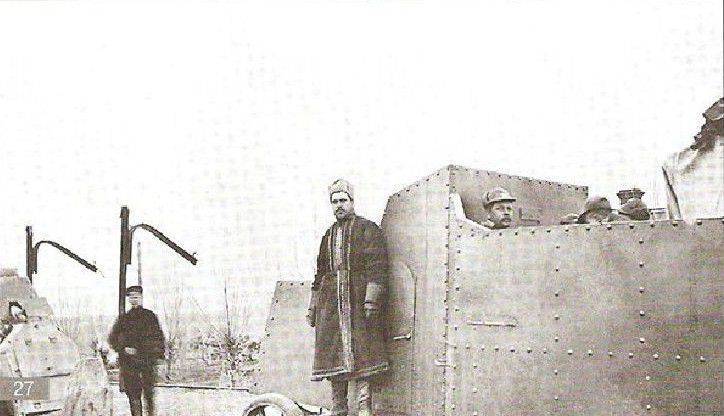
Armored car of the second series. The enlarged board is clearly visible without a wide embrasure. Photo Baryatinsky MB, Kolomiets M.V. Armored cars of the Russian army 1906 – 1917
Two new cannon armored cars were handed over to the military department at the start of 1915. Like its predecessor, they were identified in the 1-th automobile machine gun company. According to some reports, the Mannesmann-Mulag vehicles served in the 1 and 4 platoons. The further fate of these machines is almost unknown. There is information about the continuation of their operation over the next few years.
According to some sources, both cannon armored vehicles survived until the beginning of the Civil War, after which they became the property of the Red Army. Together with them, the Red Army got several other machines of other types. Details of the combat operation of the equipment are largely unknown.
One of the armored vehicles "Mannesmann-Mulag" 7 November 1918, participated in the parade dedicated to the first anniversary of the October Revolution. In 1921, an armored car of this type was listed on the balance of one of the repair plants. Shortly thereafter, it was dismantled and disposed of. For several years of operation, this machine managed to work out all its resource. In addition, its characteristics no longer met the requirements of the time. The armored car could only be disassembled. So ended story first domestic serial armored car with cannon armament.
Based on:
http://aviarmor.net/
http://zonwar.ru/
Baryatinsky MB, Kolomiets M.V. Armored cars of the Russian army 1906 – 1917 - M .: Technics-youth, 2000
Solyankin A. G., Pavlov M. V., Pavlov I. V., Zheltov I. G. Domestic armored vehicles. XX century. - M .: Exprint, 2002. - T. 1. 1905 – 1941
Information